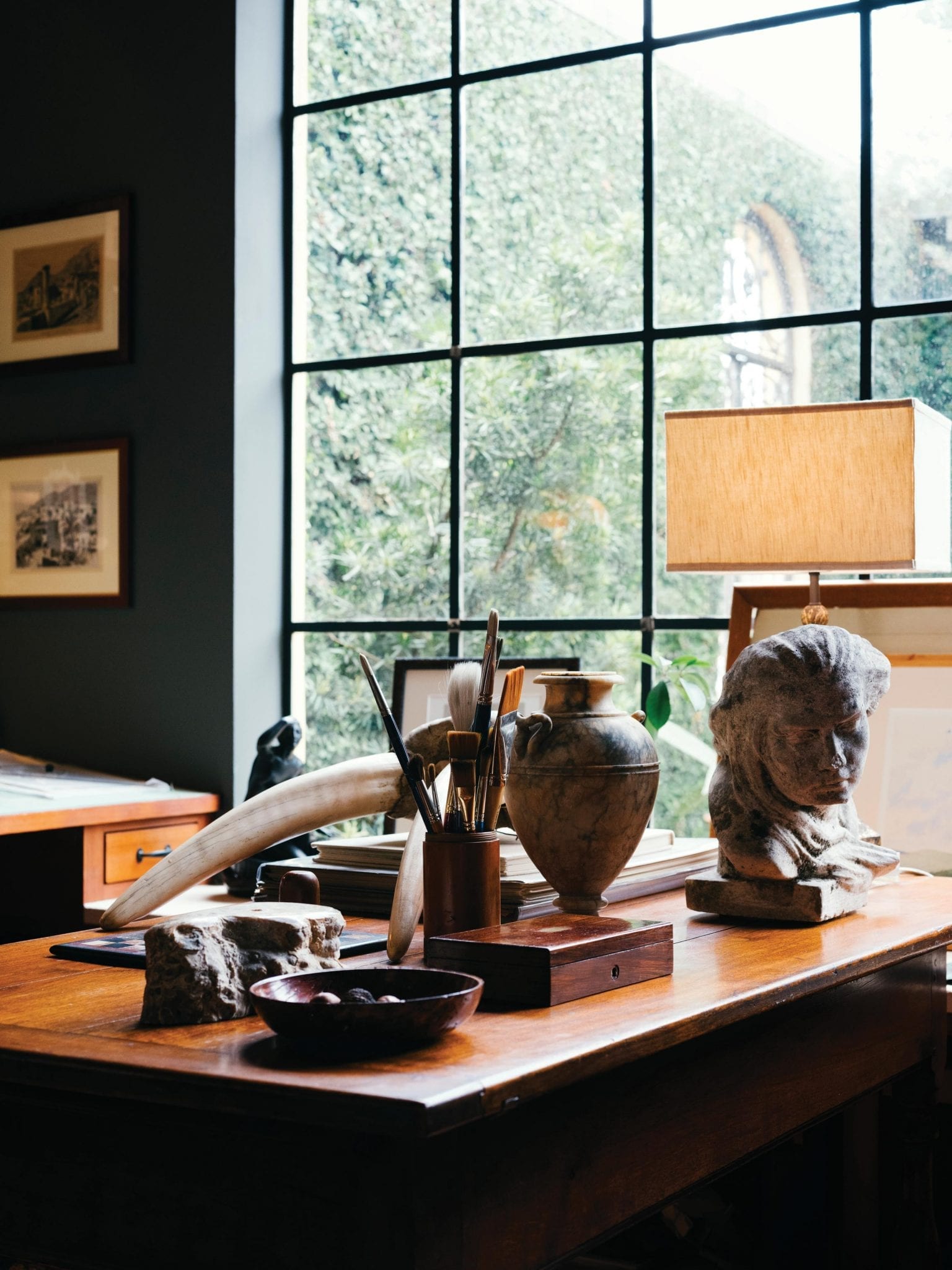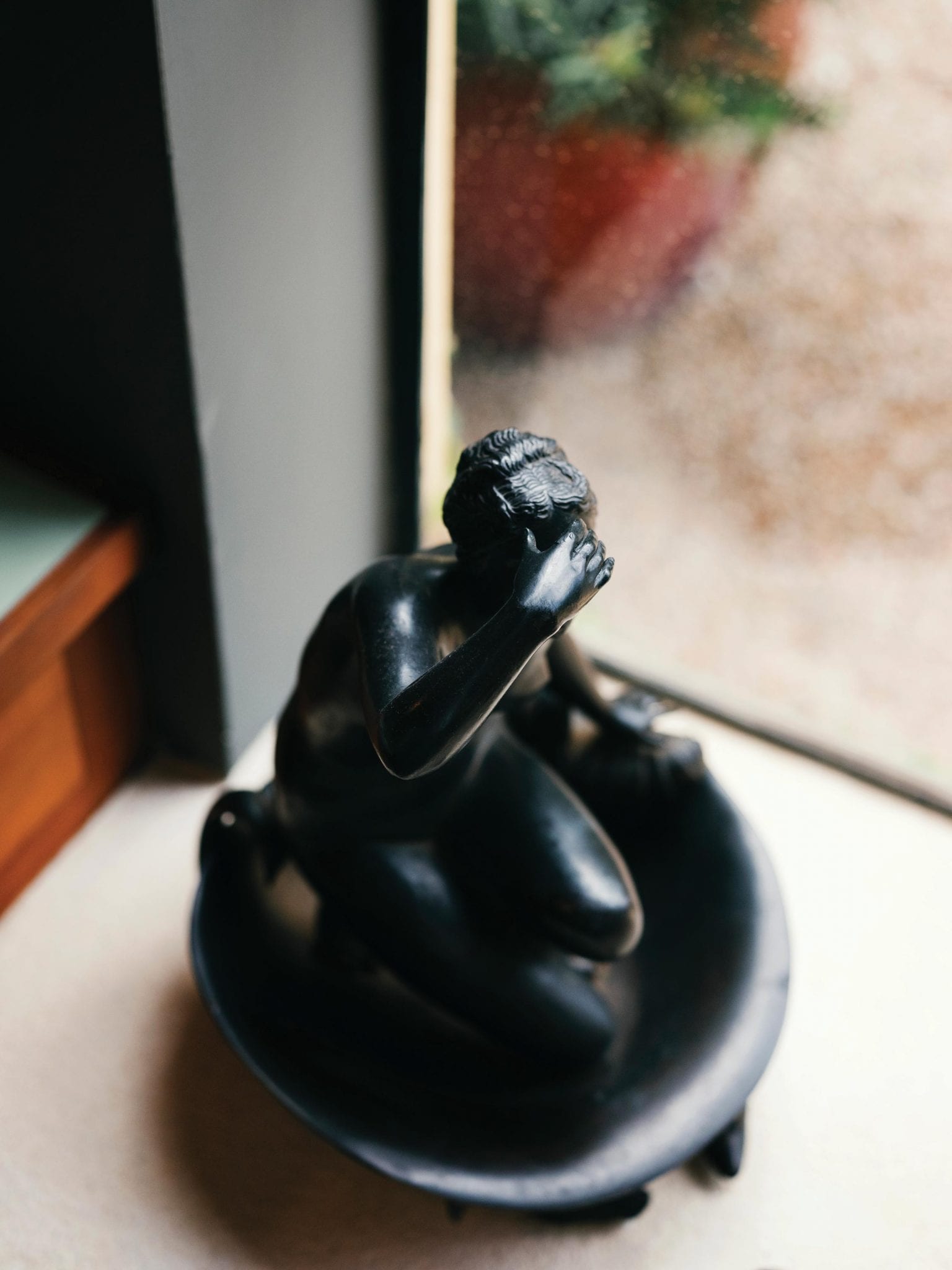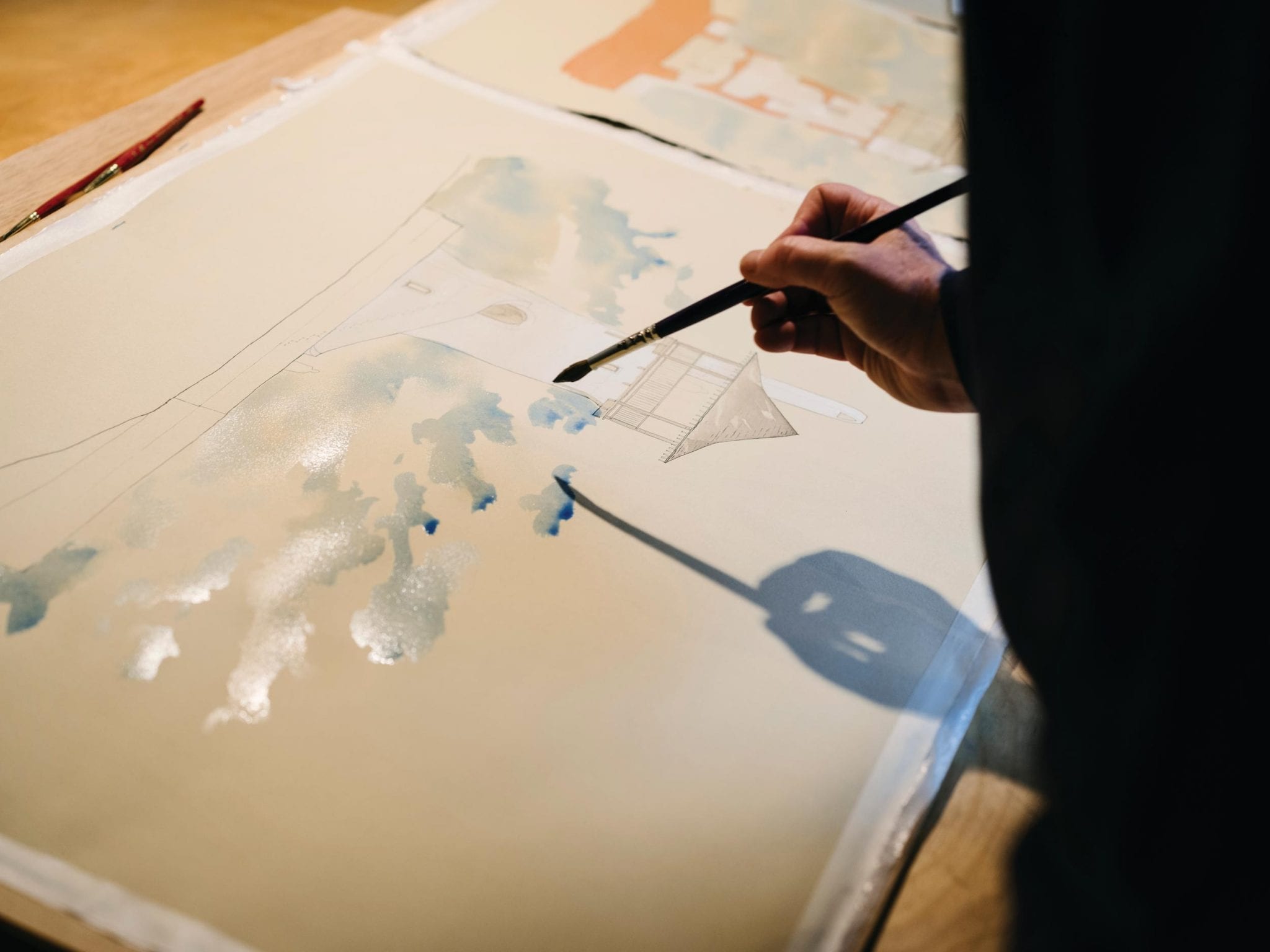

As we continue our series of conversations with the architects who have shaped Alys Beach, we spent time in San Antonio with modern classicist architect, Michael G. Imber. He shares his thoughts on how history and landscape influence design as well as where he finds inspiration in his own life.
It is not difficult to imagine a young Michael Imber standing on the “flat and featureless” landscape of his west Texas childhood home, looking out at the vastness, what many have called the nothingness, and being moved. Only a boy, he is noting what is there as much as he is noting what is not. He feels the sun on his face, the dry wind, the dust and the silence, and he is recalling the remains of a home he once stumbled upon with his family, built of this landscape’s materials, and he is imagining the craftspeople who built that home, and the family who lived in that home, the hardships they faced, struggles endured, joy they felt. He thinks of how the walls gave them a space for their memories and a space to create new ones and of how those have been passed down, in some way, and remain still even in the ruins.
It is not so different from what Michael Imber does today. The landscape as his leader, he pays attention. He imagines. He calls upon history. He builds buildings that hold stories, homes that hold memory and meaning. There is no distinction between his work and his life because there is no distinction between Michael Imber the man and Michael Imber the architect. He is himself, believes what he believes, and his work is, as his life is, an exploration of wholeness, an ongoing effort in all things to honor what has come before, learn from it, celebrate it, find what is most authentic about it, and give it the space to exist in the world as we know it today.
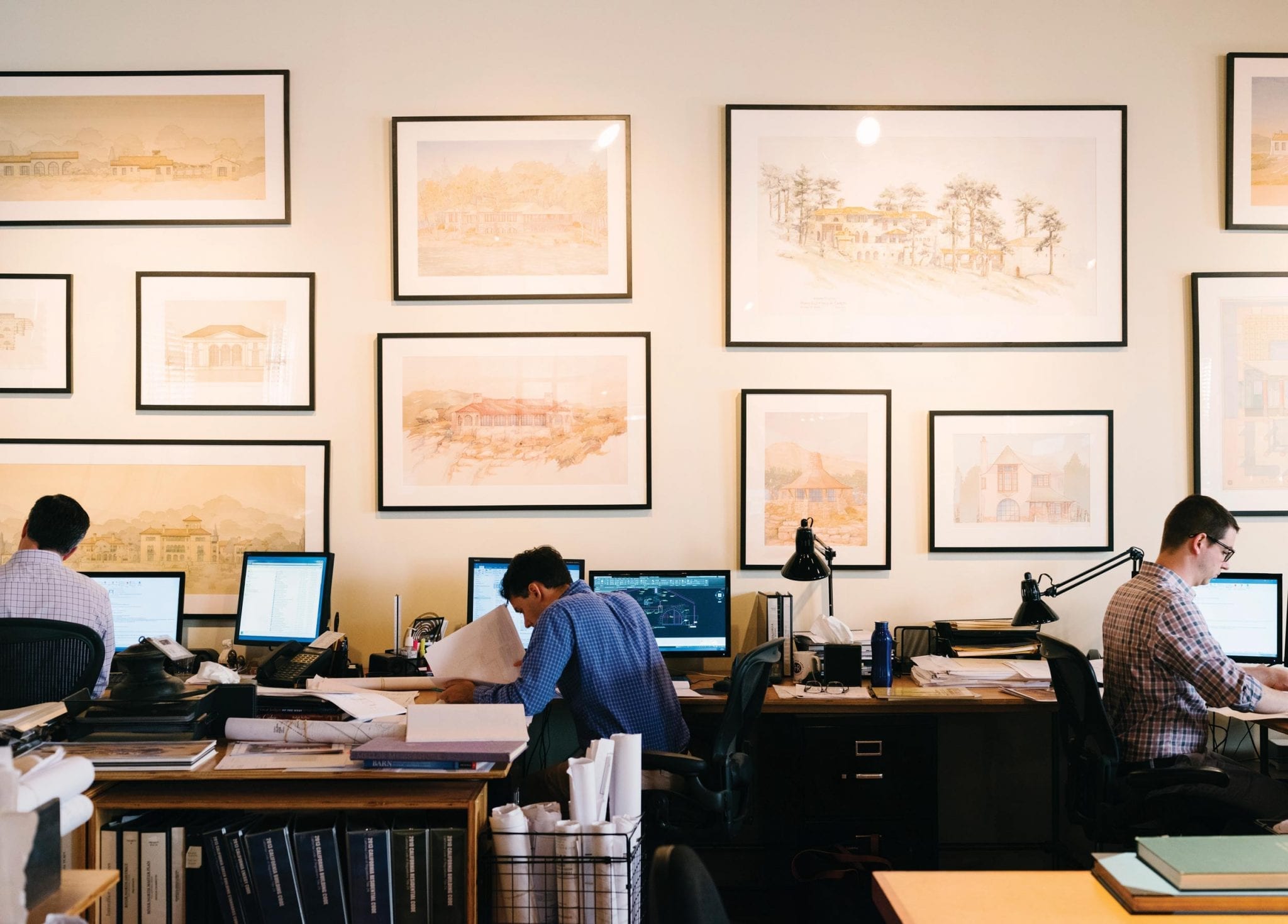

Cassie: Tell us about where you grew up.
Michael: Originally from Texas, born and raised. Born in Houston, raised in Midland, west Texas. It was a really interesting place to grow up because it’s out in the middle of nowhere. It’s flat and featureless and you would think that it wouldn’t be a good place to nurture imagination, but I always felt it was just the opposite. We spent a lot of time traveling the West with my family. We’d go out seeking Anasasi Indian ruins or old Indian campgrounds or old Texas forts up in the mountains, and so that gave me this thirst for exploration, I guess. I was always imagining what architecture was around the rest of the world and I fell in love with Texas architecture and the architecture of the West because it was so rudimentary to where it was built. They had limited materials and limited resources and so the architecture was simple but at the same time poetic. You see these buildings that are left to their dusty existence these days and you think about the people who toiled to make them happen and what they dealt with back then. It’s the romance of that story with architecture.
C: As a child, were you interested in things that you can see now line up with architecture? M: I had an aunt who is my godmother who was a really talented watercolorist, so whenever I went to visit her, we would draw. She would teach me how to paint. We would wander through the woods and she would point out every single detail; all the things that you would never notice, she saw beauty in. I credit her with two things: one, training my eye to really look and see the world around me; and secondly, she gave me my first watercolor kit as a graduation present from high school which is the same kit I use today.
C: It seems in looking at your work that your focus is on having it fit in with the landscape that is there, not stand out in any way unnatural. M: Exactly. In Texas as well as many other places, you have these incredibly beautiful landscapes that once you build on them you either can diminish them forever or augment them in some way, make them even more beautiful, and so always the goal is to see ourselves as stewards of the landscape and always think of how our buildings impact it for future generations.
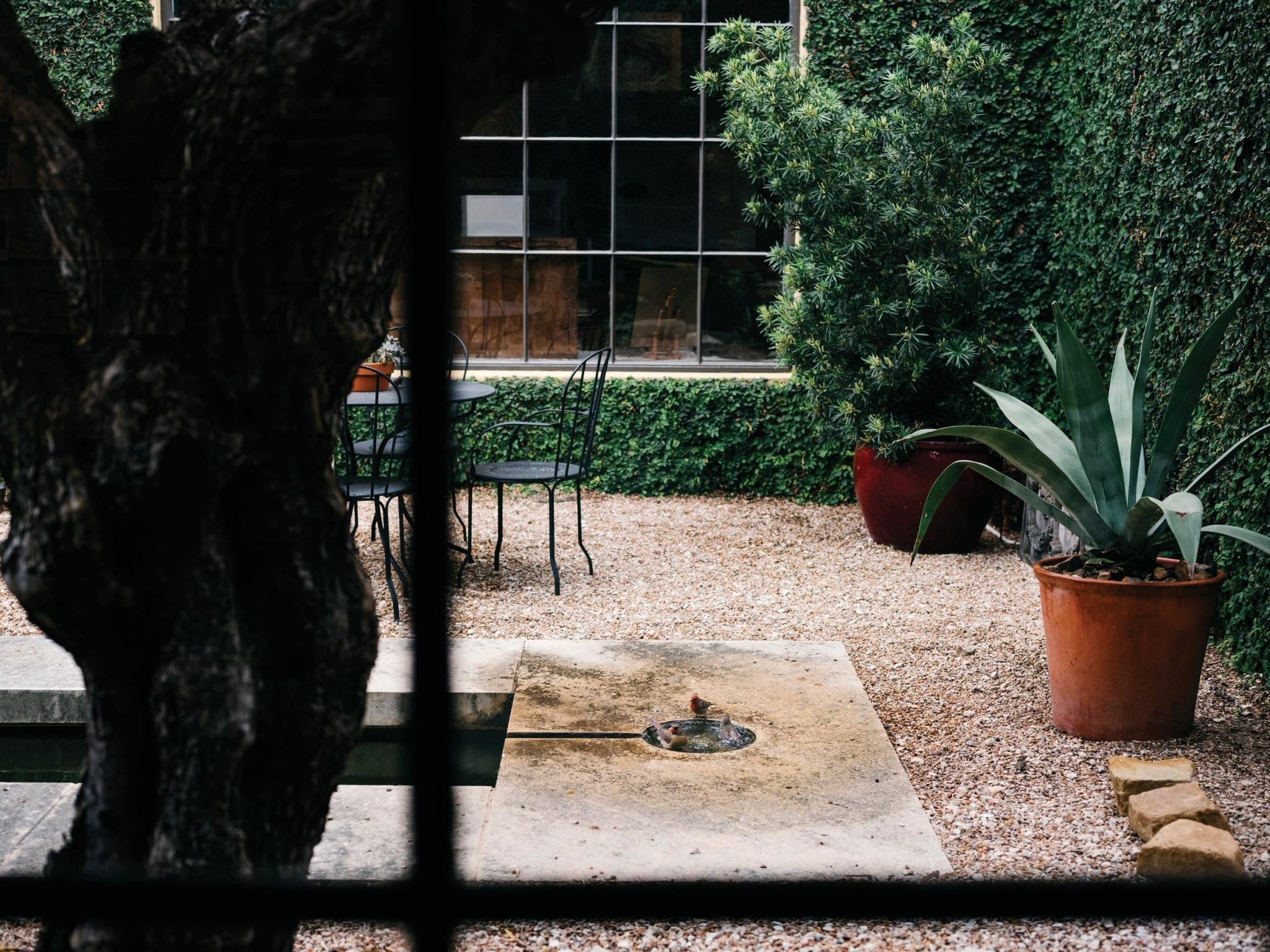

C: When you were talking about the rudimentary structures that you saw around you as a child, it seems they are the result of using the essential and using what’s already available to you so that it doesn’t stand out. M: Which means that you’re that much more connected to the landscape because you’re relying on it to shape something from so that you can exist with it. It’s back to basics. It’s kind of how the whole movement of eat locally is taking off— it’s interesting to think about architecture as build locally again. If we use the materials that the place where we’re building has to offer then it’s natural that we’re going to connect to that place in some way.
C: They seemed to know how to do it back then. M: They didn’t think about it. Texas is a good example— they brought cultures from other places and used the materials that were on hand and brought those local materials together with foreign cultures in a unique way to create something new and different. And that’s where it really gets exciting. Those are the kinds of lessons that old buildings teach us. It was natural to understand the environments that they were building in, whether or not it was Louisiana and you knew the materials that would stand the test of time, or if it were in Florida or along the Gulf Coast where you knew how to build for storms. I can remember after Hurricane Katrina going to the coast of Mississippi and seeing the buildings that made it and the ones that didn’t which were the ones built to all of our modern building codes. The buildings that made it were the old ones that were built understanding where they were building. It’s that knowledge that traditional architecture has given us that we tend to forget about with all of the “information” that we have today.
We’ve been building buildings for thousands of years and those buildings embody our knowledge and the culture that we’ve accumulated over all that time. That’s something not to be forgotten.
C: To be a modern classicist. What does that mean to you? M: Oxymoron? Or just the moron? [Laughs] What that means is that we’re informed by our pasts. We’ve been building buildings for thousands of years and those buildings embody our knowledge and the culture that we’ve accumulated over all that time. That’s something not to be forgotten. If we can tap into that gained knowledge then we’re already ahead of the game—understanding how to build with the landscape, what materials to use, how to build for a particular climate. These buildings that existed before were sustainable. We didn’t have to talk about sustainability because they lasted hundreds of years and were reused time and time again because they stood up to the elements and were beautiful where they were and were appreciated and respected. History has those sorts of lessons to teach us. Now, we don’t live as we did 100, 200, 1000 years ago. We have to respect that as well. What modern classicism means is that we have an understanding of those lessons of the past, we look to the past to learn and to gain knowledge, and then we use that knowledge to carry architecture into the future. So that we continue to live with beauty and we continue to live with the knowledge that lets buildings be naturally sustainable, but they accommodate our modern lifestyles and are adaptable to our modern lifestyles, as well as to modern technology.
C: You seem to be a real student of history. M: Yes, I love history. I guess I can’t separate our world from our history. It’s the combination of history and our landscapes that make places special. I look at San Antonio where I live and we’re celebrating our 300th anniversary. You see San Antonio rooted in a lot of those traditions that have been here for hundreds of years. At the same time you see San Antonio doing what many cities do and trying to be like someplace they’re not. Always thinking that they need to modernize, that they need to have cooler buildings and things other modern cities have, and they begin to lose what’s special to them as a place, their identity, what gives them a character that is unlike any other place. I think you can go anywhere and look at history and look at how people learn to live with the land and learn to enrich their lives in simple ways and see the stories behind different places, the different things that have happened that have impacted the way we see our cities, and the way we live within them. I’m fascinated by that, a hopeless romantic. I always think about how our buildings are going to be seen in the future and how they’re going to be part of a greater story. I think that if you think that way, you can create buildings that can be appreciated now, but could also be appreciated equally by the generations before, as well as the generations that are coming after. That’s my goal. I think that story of history is really important. We have to see ourselves as a part of that story. You see so many buildings that don’t, that are simply of the now, and if you build for now, then that’s a transient way of thinking of things. It’s not sustainable. You’re building on ideals whether or not it’s being innovative or being stylish or any number of things that are not going to have any meaning for people in the future. However, if you use history to teach you the things that are timeless, that people react to and continue to appreciate, if you can tap into that through your knowledge of history then you can build buildings that are more sustainable.
C: Your watercolors and drawings are so amazing; they stand alone. Did you have any formal training? M: No, no formal training at all. Like I said, I liked to draw with my aunt as a child and I continued to draw, I continued to teach myself watercolors. It’s interesting that in my generation most of us are self-taught whereas this new generation of classical architects have actually been trained to watercolor and to work on their graphic skills. Unfortunately, whereas Notre Dame and those schools do that in a very active way, most architectural schools have eliminated drawing almost entirely from their programs today. I think that’s a very sad thing.
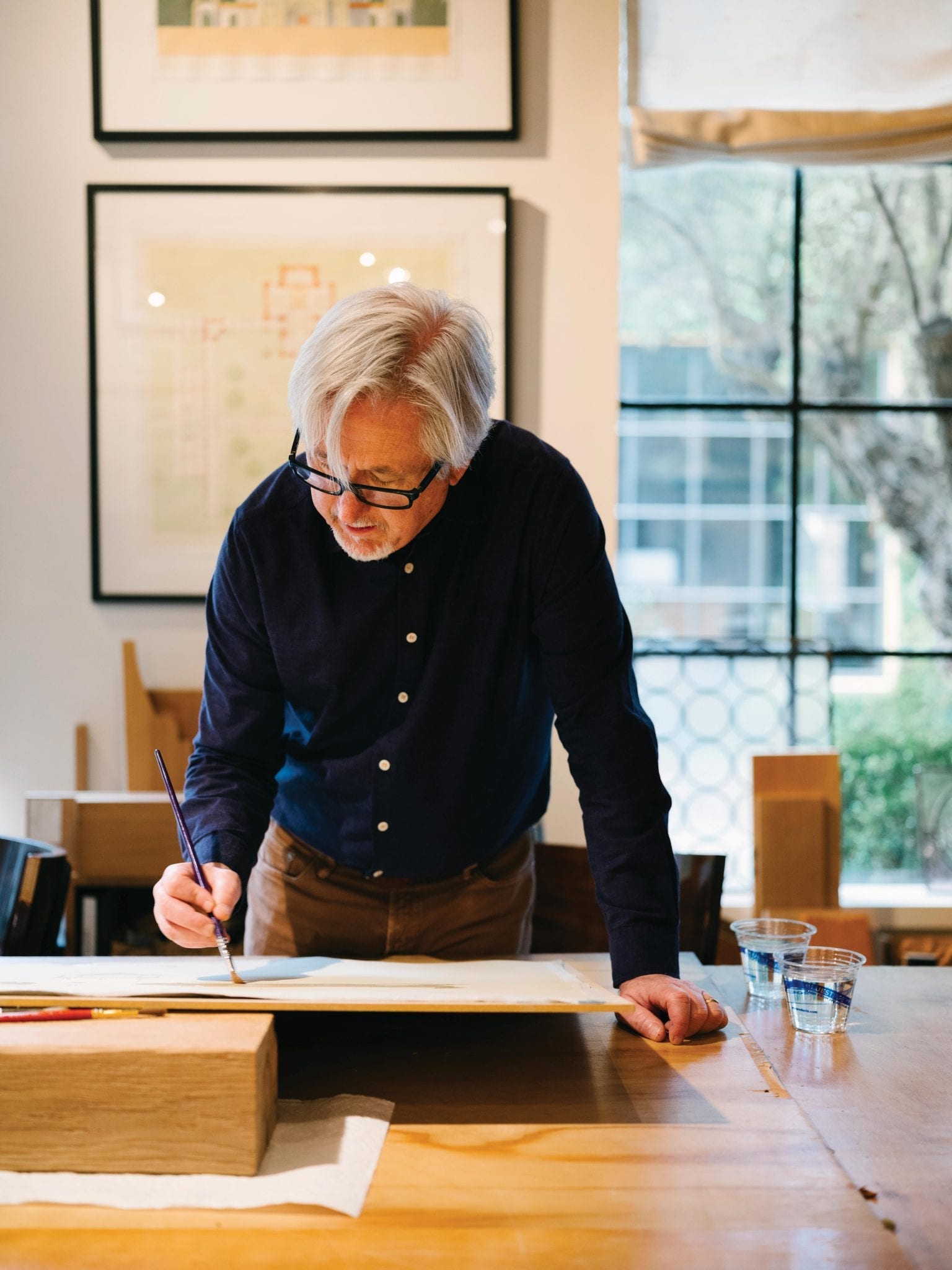

C: Drawing by hand seems a bit rare these days, or old school. M: Yeah, well don’t call it old school (laughs). To me, I see drawing as much of another language as anything else and if you can teach yourself to draw fluently then there is no translation between the imagination and the conceptualization within your head to what flows out on a pencil onto paper. So, it’s fluid. To me that is what architecture has always been. It’s been much more of an art than it is today where things have a tendency to get drafted out on computer and once a line goes down on a computer it’s more or less permanent. It’s not teasing out an idea, it’s laying out in a rational manner what something should be, rather than imagining what something could be. There’s a big difference in the way that design is happening today on computer than how design has happened in the past by hand.
C: And that’s part of your process. I would imagine a pretty early part. M: Yes, and it doesn’t only start with just drawing for conceptualizing a project. It starts with, if I’m somewhere unique or interesting or someplace that has some influence on the way I think about architecture—for me to sit and draw it, helps me to actually see it and understand it. If I just take a picture of it, I’m just going to take that picture and go store it away on my computer and maybe one day recall it and look at it, but I don’t really understand it. And it’s more than just understanding a detail or proportion or composition. Say I’m in Tuscany, and I sit down to draw a building—I sit down on a stone wall, I feel that stone, I can smell the earth that the grapes are growing in, I can feel that Tuscan sun on the back of my neck, I can smell the grapes on the breeze, I can hear the birds sing. I get to understand that place, fully, and so it’s just like listening to music to anybody else. When you go back to that drawing, you see that place again. You truly understand it. You feel it. It’s something that’s now inside of you. And so that’s a different way of looking than just taking a picture.
C: How does modern classical style work in the architectural, historical, and cultural landscape of Texas? Or rather, how do they inform each other? M: It’s no different than any other place just like we’ve been talking about. Texas has a very bold history, some parts more than others. Texas has many different landscapes, unique landscapes, and so whenever we build, it’s this idea of what is special about this landscape and how can this building reflect that and how can this building speak to the history of this place in a way that— and this word is so overused, but—is timeless. The last thing in the world we want is for our buildings to speak of a particular time. They want to take and embody all the time that has happened before. Everything that the landscape stands for. They want to capture the spirit of the history of that place. And shout it. I can’t say shout it. Some buildings shout it, some whisper it, but there’s a nuance to everything we do whether or not it’s the type of stone or the type of sand that goes into the grout between the stone. The process is no different than building in Colorado or Maine or North Carolina or Florida or anywhere else. We really try to listen to that place and try to understand how can we connect to it in some way.
Home is where your earliest, fondest memories start. That’s where you form who you are as a person. The building that shelters those memories is also important because it’s there along with everything that happens within its walls to help form those memories. Those memories eventually leave that place and are taken to so many other places that help influence the rest of the world. Buildings are a big part of that.
C: What does home mean to you? M: That’s a loaded word. I can either write a book about this or I can put it into one word. And that’s memory. Home is where your earliest, fondest memories start. That’s where you form who you are as a person. The building that shelters those memories is also important because it’s there along with everything that happens within its walls to help form those memories. Those memories eventually leave that place and are taken to so many other places that help influence the rest of the world. Buildings are a big part of that. How we form those memories at home and how the architecture of the home helps embody those memories is something crucial to how we end up living our lives and sharing our lives with other people.
C: If you can take that to a place a little more specific, what gives a house longevity and gives it a sense of story and history? What makes it feel like home for people and maybe this is on a personal level, beyond just the landscape, but how do you give a client a house that becomes a home? M: In using an example, if I were to build a home, that home would be influenced by all those things my godmother taught me and by all those fond memories that I gained from her, all those fond memories that my father gave me, my mother, all those trips that we took as children, all of those things would influence the home I built. Then those memories that helped build that home would help form my children into who they are as adults and as people going out into the world. I would hope that the home I built, that if my father and mother or grandmother came to that home, they would be comfortable because there’s a connection to those memories. There’s something that’s meaningful that is a string that stretches between all of us. And eventually I hope that my grandchildren will be able to come to that home and be a part of that string of memories that has created that place. And create meaning in their lives as well. Does that just sound like… (laughs).
C: Can you speak to your feelings about Alys Beach, about what it’s like to design a house there? M: Alys Beach is an interesting place because it’s built in a place that, for the most part, is devoid of history. There is some lighter vernacular history that’s happened in the place, but really we’re creating a new place with a language that’s important. So, it’s an invention of what a place can be—not what it was, but what it can be. So, it’s fascinating in many ways. The thing that fascinates us the most in working with Alys Beach is the fact that the buildings are all masonry and they’re all white. It’s a different process of design than what we typically go through. Most architecture is an additive process. You have a room that’s connected to a room that’s connected to a room. A mass that has a relationship with a different mass and so on. Alys Beach is more of a deductive process. Much like an artist or a sculptor with a piece of marble looks at a block and has to think what’s within that block and how can I bring that out of that stone. That’s how we approach a lot of our architecture there. What is the form and the composition and the spaces within that within that block that is allowed on that piece of property in Alys Beach. It’s the subtraction and taking away pieces that end up creating. We get to play sculptor a little bit. Try to imagine. Alys gives you a form-based code and so you have your lot and they say you have to build out to these property lines and you have to build this tall and so they’ve given you this rectangular space that you’re to occupy with a building. And so rather than building up to occupy out to the edges, we like to look at those edges and subtract from to create the structure from that. It gives you something very sculptural in the end.
C: Can you tell us what inspires you? What in your day-to-day life gives you energy? M: I can say the possibility of creating something authentic today. That’s the biggest challenge for architects. In a world that’s indeed been flattened, how do you create something that’s unique and still embodies meaning? That’s what I hope to do and what we strive to do and everything I do whether it’s watercoloring in Italy or trying to figure out how to build a stone wall or the color of a plaster bench—it’s trying to understand how that connects to who we are as people and what’s meaningful.
C: You travel for work often. Do you have days of leisure? What would they look like? M: My greatest joy is our home on an island in Maine. It’s very hard for me to have an hour or two of leisure. I have to get away from it all to really disconnect with the pace and the routines that happen in architecture and so that place is on our island in Maine. Living next to the sea, being on a sailboat, really enjoying nature, and being away from everything.
C: So, what are you eating and drinking on this island in Maine? M: Drinking a lot (laughs). We have this wonderful porch that overlooks Hurricane Sound and all of these little conservation islands. We’ll sit out on our porch and we’ll have cocktail hour or we’ll spend time out on the boat. I love to cook so I spend time cooking and painting, hiking, and just enjoying what life should be about.
C: I did see that you have recipes on your blog. Do you have a favorite thing to cook? M: One thing I do, try to do, is every Sunday—I work seven days a week—so on Sundays I try to knock off around three o’clock in the afternoon, put on some good music, there’s a gourmet market down the street, buy what I’m going to cook that evening, and spend a couple of hours in the kitchen whether or not it’s something simple like shrimp scampi or something more complicated like spaghetti bolognese or beef bourguignon, I find it really nurturing to have those few hours once a week in the kitchen to give me a break so I can walk in the office Monday refreshed and start over again. So, my one real I guess luxury is that few hours on a Sunday afternoon where I don’t have to think about anything else but how large do I need to chop that garlic?
C: Is there anything else you’d like to add? M: I’d say I’m fortunate to do what I do because I love what I do. Everyone in the office is passionate about what we do because we feel like we’re impacting people’s lives. Creating special places and buildings that touch people’s lives. It’s important to us.
C: Thank you, truly.




